
Features
Agronomy
Corn
A better understanding of re-cropping
Research looked at which crops could be re-cropped the year after Everest, as well as the effectiveness of lower wild oats rates.
November 29, 2007 By Bruce Barker
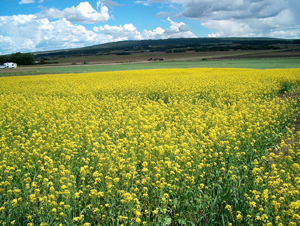 |
| In the trial, canaryseed showed good tolerance to Everest residues. Photos Courtesy Of Ken Sapsford, University of Saskatchewan. |
As a herbicide with soil residual activity, Everest has restrictions on what
crops can be re-cropped the year after application. Currently, the label outlines
the crops that can be planted 11 months after application, based on soil zone,
organic matter and pH, as well as precipitation in the 60 days following Everest
application. With the new, lower wild oats rates registered for Everest, Arysta
LifeScience contracted the University of Saskatchewan to investigate whether
lower rates allowed a greater range of crops to be planted the year after Everest,
as well as provide additional third party research on the effectiveness of wild
oats control.
"We looked at the new, lower rates to assess wild oats control and whether
the lower rates would allow different crops to be grown the following year,"
explains the University of Saskatchewan's Ken Sapsford.
The new label for Everest has three rates for grassy weeds: a green foxtail
rate of 8.7gm/ac (15gai/ha) treating 66 acres per jug; a low wild oats rate
of 11.5gm/ac (20gai/ha) used for light to moderate infestations treating 50
acres; and a higher wild oats rate of 17.4gm/ac (30gai/ha) treating 33 acres
for use when wild oats populations are heavy or during dry or cool weather conditions.
Previously, the Everest wild oats rate was 30gai/ha (grams of active ingredient).
|
Table 1. Re-cropping 11 months after Everest summary. Note: Number on chart represents the percent of plots that had injury on a four replication trial.
|
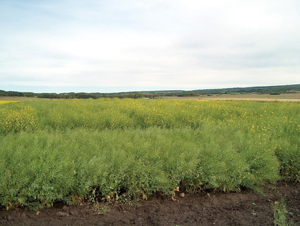 |
In the research, conducted from 2003 to 2006, Everest showed very good wild
oats control at the 20gai and 30gai rates, with control greater than 90 percent
in most site years. When compared to Puma and Axial, Sapsford says that Everest
showed the typical soil residual wild oats control.
"The control gets better with Everest later in the season. It has typical
Group 2 activity. It has a slower activity, but the control is there,"
says Sapsford.
Sapsford explains that in the research, Everest was applied at the 20gai or
30gai rate at the two leaf stage, while Puma was applied at either the two leaf
or six leaf stage, and Axial at the six leaf stage. The wild oats control ratings
were taken at 21, 26 and 60 days after the two leaf stage application, which
is the reason the six leaf stage applications do not have any data for the first
two ratings. Sapsford also explains that with Everest, where the occasional
wild oats escaped control, the wild oats plants did not set seed.
Statistically, similar yields between Everest and Puma at the two leaf stage
were observed, but early applications had higher yields than the later applications,
which indicates that early weed removal will usually produce the highest yield.
Re-cropping study improves understanding
To assess crop safety for re-cropping, researchers like to see a safety margin
that will allow for overlaps of the sprayer. Essentially, a crop needs to be
able to grow on land that has double the label rate to provide a comfort level
for researchers. That means with the new, lower wild oats rate of 20gai, researchers
need to be comfortable with re-cropping on plots treated with 40gai; and for
the 30gai rate, a safety margin as reflected by the 60gai plots.
At the University of Saskatchewan, two different trials were conducted, one
in 2003/04 on a silt loam soil with five percent organic matter and a pH of
7.3. Everest was applied in 2003 and the plots were re-cropped in 2004 with
14 crops. Another trial running from 2004 through 2006 narrowed down the crops
on a clay soil with organic matter of four percent and a pH of 7.6.
| Figure 1. Visual wild oats control, August 8, 2006. Note: There may be some Group 1 resistant wild oats at this location, which is why Puma may have lower wild oats control ratings. Source: Ken Sapsford, University of Saskatchewan. |
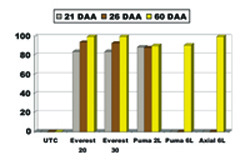 |
In 2004, Sapsford says that Roundup Ready canola had no problem with Everest
residual at the 60gai/ha rate, and barley and alfalfa also appeared to have
good tolerance. Oats, canaryseed and field peas looked questionable, while the
lentils crop was very poor with no yield. Schilling explains that field peas
showed higher levels of injury due to lower than average rainfall in the year
of herbicide application, while the lentil crop was very poor with significantly
lower yield than the untreated.
Brian Schilling, technical service representative with Arysta LifeScience at
Edmonton, Alberta, says the company still supports peas in the Dark Brown soil
zone as long as moisture is adequate, as well as pH and organic matter guidelines
are observed.
In 2005, lentil and corn yields, when grown on Everest treated land at the
60gai/ha rate, were only about 70 percent of the untreated check. The other
crops were not statistically lower.
In 2006, Sapsford cut the study back to eight crops, throwing out corn and
lentils because they did not show tolerance in the previous years and canola,
wheat, flax, soybeans, pinto beans and sunflowers because they had already demonstrated
good tolerance to Everest residues. That year, oats was the only crop with statistically
lower yields at the 60gai/ha rate, but canaryseed and the mustards had visual
symptoms of crop injury. "If we reduced it to the 40gai rate, then canaryseed
might be okay to re-crop after Everest, but oats is still questionable,"
says Sapsford.
| Figure 2. 2006 yield of crops following 40gai/ha Everest. Source: Ken Sapsford, University of Saskatchewan. |
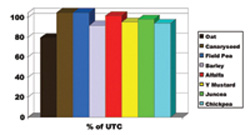 |
Sapsford summarizes the re-cropping trials with a chart that combines visual
injury ratings and yield ratings over the three years. He says the chart gives
a good indication of which crops might be potential candidates for re-cropping
and which crops should definitely not be grown the following year after Everest.
Crops with no visual injury or yield loss had a zero rating, indicating the
potential for re-cropping without injury. He also colour-coded other treatments
with green, yellow and red. Green indicating that re-cropping might be safe,
yellow for caution, and red to indicate danger of crop injury and yield loss.
In the chart, Sapsford also drew a line around the crops that might be good
candidates for re-cropping after the new lower 20gai/ha rate, allowing for a
2X safety cushion. "The trials showed that the 20gai/ha rate provided similar
weed control as the 30gai rate," says Sapsford. "There also appears
to be more re-cropping opportunity with the 20gai rate under the conditions
of our study."
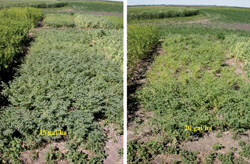 |
| Chickpea re-cropping showed injury even at low rates. |
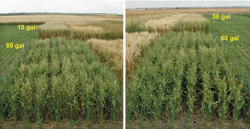 |
| Oats planted 11 months after Everest showed little injury at lower rates. |
Schilling says that the company does not have immediate plans to apply for
new re-cropping changes to the Everest label. Rather, he says the research was
conducted to gain a better understanding of how to increase the safety of existing
crops registered for re-cropping on the label.
To expand the re-cropping label, he says they would need to conduct further
studies in other soil zones to develop better guidelines outside of the Dark
Brown soil zone where the University of Saskatchewan study was conducted. As
a result, he recommends growers adhere to the current label to ensure they do
not sustain crop injury the year after application.
"Our intent was to create a greater comfort level when re-cropping after
Everest," explains Schilling. "We're assessing whether we should continue
the research to expand the re-cropping label." -30-